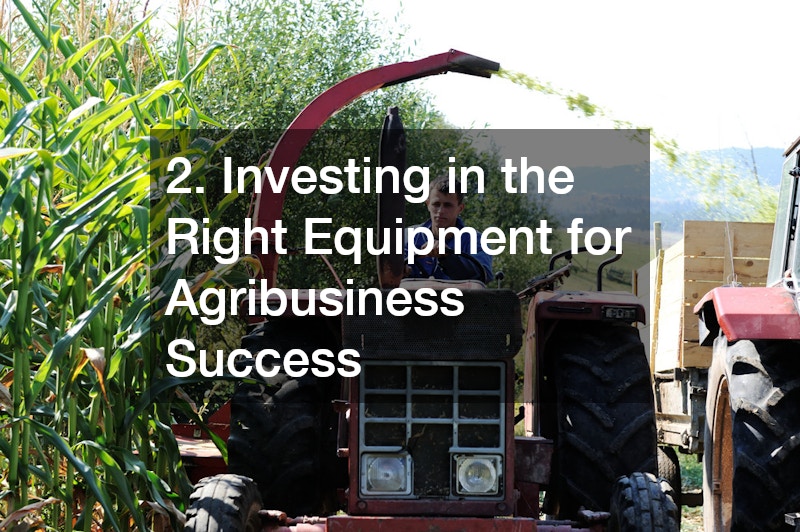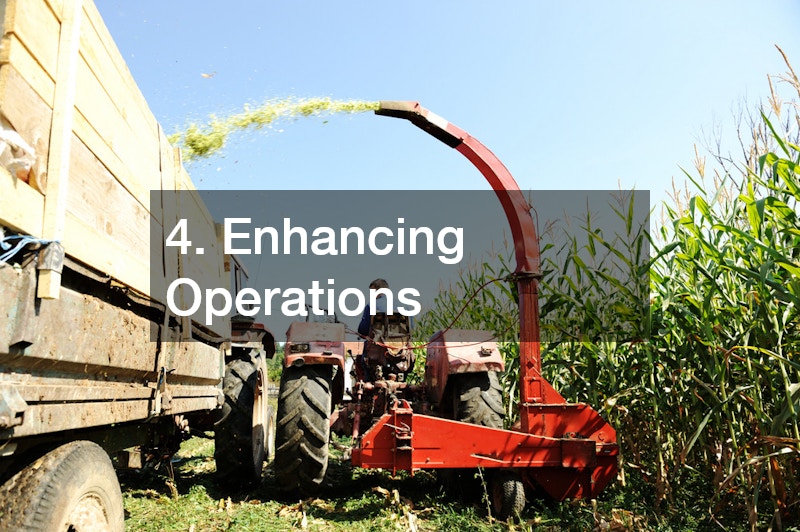Agriculture remains one of the most crucial industries worldwide, and managing an agribusiness successfully involves more than just planting and harvesting crops. With global trends shifting toward sustainability, technology, and profitability, it’s essential to adopt modern strategies that ensure both short-term and long-term success. This guide will explore the key areas to focus on to help you create a profitable agribusiness in 2025.
1. Creating a Robust Business Plan for Success
A business plan is the foundation of any successful agribusiness. It provides direction, sets clear objectives, and is essential for attracting investors. A well-crafted plan should cover all aspects of the business, including financial forecasts, market research, and growth strategies. Here are the key components of a strong agribusiness plan:
Executive Summary:
The executive summary introduces your business, including its mission, products, target market, and competitive advantages. It should highlight your business development strategies and growth potential, aiming to capture the attention of potential investors or partners.
Market Research:
Conducting thorough market research is crucial to understanding consumer demand, market trends, and the competitive landscape. By identifying your target market, you can tailor your offerings and marketing strategies to meet customer needs and differentiate your business.
Financial Projections:
Financial projections demonstrate your agribusiness’s growth potential to investors. Include revenue forecasts, cost estimates, and a break-even analysis. This section should clearly outline your funding needs and expected return on investment.
Risk Management Strategy:
Agribusinesses face various risks, from environmental challenges to market volatility. A solid risk management plan outlines strategies to mitigate these risks, such as diversifying products or securing insurance, ensuring business continuity even in the face of unforeseen events.
A strong agribusiness plan provides the blueprint for success. Regularly reviewing and updating it helps adapt to industry changes, ensuring your business stays on track and ready for growth.
2. Investing in the Right Equipment for Agribusiness Success

Investing in high-quality, modern equipment is vital for maximizing productivity and efficiency in your agribusiness. Whether you’re managing a crop farm, livestock operation, or processing facility, the right tools are essential to optimize operations and improve profitability. Here’s a breakdown of key equipment investments for success in agribusiness:
Tractors and Harvesters:
Tractors and harvesters are essential machinery for nearly every type of agribusiness. These machines handle everything from plowing and tilling to planting and harvesting, making them crucial for crop production. When selecting tractors and harvesters, it’s important to choose models that match the scale and type of your operation. Look for machines with the right horsepower, capacity, and advanced features like GPS tracking or automated steering to enhance productivity and reduce labor costs. Additionally, investing in local tractor sales can provide access to specialized equipment and support tailored to your needs.
Harvesters, in particular, are critical for efficient crop collection, reducing waste and ensuring that harvests are completed quickly and with minimal loss. Choosing modern, efficient equipment helps improve both the speed and quality of harvests, ultimately boosting your profits.
Irrigation Systems:
Water is a critical resource for agricultural production, and efficient irrigation systems are key to maximizing crop yields while minimizing costs. Modern irrigation technologies, such as drip irrigation and advanced sprinkler systems, allow for targeted water delivery that reduces waste and optimizes water usage. By investing in high-quality irrigation systems, you ensure that your crops receive the appropriate amount of water at the right time, promoting healthy growth while conserving this valuable resource.
Smart irrigation systems that are programmable or sensor-based can help you monitor soil moisture levels and weather patterns, ensuring that irrigation is only applied when necessary. This can significantly reduce water costs and increase sustainability, making it a smart long-term investment.
Planting and Seeding Equipment:
Automated planting and seeding equipment is a game-changer for agribusinesses, particularly those focused on large-scale crop production. These systems can significantly reduce labor costs while improving planting accuracy and speed. With the right planting equipment, you can ensure precise seed placement, even distribution, and proper soil depth—all of which are crucial for maximizing crop yields.
Automated planting systems also help optimize the use of resources such as seed, fertilizer, and water, as they allow for precise control over each planting operation. Investing in modern, high-efficiency seeding equipment reduces the risk of human error, enhances consistency, and boosts overall farm productivity.
Specialized Transport for Heavy Equipment and Large Loads:
In addition to the core machinery used in planting, harvesting, and irrigation, it’s important to invest in specialized transport equipment like lowboys. These low-profile trailers are designed to carry heavy and oversized equipment, ensuring that tractors, harvesters, and other large machinery are transported safely and efficiently. Lowboys are particularly useful for agribusinesses that need to move large equipment between fields or facilities.
When purchasing transport equipment, consider both its capacity and durability. Investing in high-quality lowboys ensures that your machines and equipment are transported without risk of damage, helping maintain the integrity and lifespan of your assets.
3. Building Strong Infrastructure

Building strong infrastructure is essential to the success and growth of your agribusiness. Infrastructure is not just about buildings; it encompasses everything from utilities to roads and storage facilities that enable smooth day-to-day operations. With a solid infrastructure in place, you can ensure operational efficiency, enhance productivity, and better position your business to meet market demand.
Storage Facilities:
Storage facilities are critical to maintaining the quality and safety of your agricultural products. Depending on the nature of your agribusiness, storage solutions might include grain silos, refrigerated units, or barns for livestock. Proper storage prevents spoilage, contamination, and waste, helping you preserve the value of your products until they are sold or processed.
For crops like grains, ensuring the right temperature, humidity, and airflow in your storage units can make a significant difference in the quality and shelf life of your produce. For livestock, investing in well-ventilated barns with proper waste management systems is essential for animal health and the quality of your products.
A crucial aspect of storage facility construction is roofing, which protects your products and equipment from weather-related damage. A durable, high-quality roof keeps your storage units and products safe from environmental elements, such as rain, heat, or snow. Investing in a reliable roofing system can also contribute to better energy efficiency, reducing your heating or cooling costs. Building or upgrading storage facilities with quality commercial roofing should be a priority in any agribusiness infrastructure plan to protect your products and support your bottom line.
Transportation Network:
A strong transportation network is crucial for delivering your products to market efficiently. Whether you own a fleet of trucks or require access to railways and ports, reliable transportation logistics are key to keeping your supply chain moving. A well-developed network ensures that your products reach their destinations on time and in good condition.
Incorporating multiple transportation options—such as trucks, rail, and even waterways—into your logistics plan provides flexibility and mitigates risks related to potential disruptions. Investing in vehicles that are specifically suited to your products, such as refrigerated trucks for perishable items or flatbeds for heavy equipment, will help you maintain efficiency and reduce the likelihood of damage during transport. Moreover, a gooseneck enclosed trailer can be a versatile option for hauling sensitive or valuable goods, providing both protection and stability during transport. This type of trailer is especially useful for longer distances or when you need to secure your products from external elements while in transit.
Energy Supply:
Agribusinesses rely heavily on energy to power everything from irrigation systems to processing plants. Ensuring a reliable energy supply is essential for uninterrupted operations. Traditional energy sources, such as electricity and diesel, are often necessary, but renewable energy options like solar or wind power can offer significant long-term cost savings.
Investing in renewable energy sources not only reduces operating costs over time but also aligns your business with sustainable practices, which can be a selling point to eco-conscious consumers and partners. Additionally, a stable energy supply ensures that critical operations—such as crop irrigation or livestock care—are not disrupted by power outages, keeping your business running smoothly.
4. Enhancing Operations

Optimizing your agribusiness operations is essential for increasing efficiency, reducing costs, and ensuring consistent production. Streamlining workflows, managing labor effectively, and maintaining consistent product quality will not only improve short-term profitability but also set the foundation for long-term success. Here are some key strategies to enhance your operations:
Process Automation:
Process automation is one of the most effective ways to optimize agribusiness operations. From planting and irrigation to harvesting and packaging, automated systems can significantly increase efficiency by minimizing human error and reducing the time spent on manual tasks. For example, automated irrigation systems can ensure precise water distribution, optimizing water usage and reducing waste. Similarly, automated planting and harvesting machines can speed up crop production while improving yield consistency.
In addition to reducing labor costs, automation also helps improve the accuracy of operations. Automated systems ensure that tasks are performed consistently, which is essential for maintaining product quality and adhering to industry standards. Implementing automation across various stages of your agribusiness will enhance productivity and allow you to scale more effectively.
Inventory Management:
Effective inventory management is crucial to prevent shortages, waste, and stock-outs. Whether you’re managing raw materials, finished products, or equipment, keeping accurate records ensures that you have what you need when you need it. Technology can significantly improve inventory management. For example, Internet of Things (IoT)-based systems provide real-time tracking of your inventory, offering alerts when stock levels are low or when expiration dates are approaching.
Incorporating software tools that integrate inventory management with other aspects of your operations—such as ordering, production, and logistics—ensures that your supply chain runs smoothly. This level of visibility allows you to make data-driven decisions, such as adjusting production schedules or purchasing new materials, to avoid costly disruptions.
Labor Management:
Labor management is key to maintaining a productive and cost-effective workforce. Efficient scheduling ensures that you have the right number of employees at the right times, minimizing downtime and overstaffing. Implementing a robust scheduling system helps optimize shifts based on seasonal demands and workforce availability.
In addition to scheduling, investing in training programs is essential to improve employee performance and reduce errors. Well-trained staff are more efficient and capable of handling a variety of tasks, making your operations more versatile and resilient. Furthermore, employee retention strategies, such as offering competitive wages, incentives, and career development opportunities, can reduce turnover and enhance the stability of your workforce.
Implementing Performance Metrics:
One of the best ways to enhance operations is by regularly analyzing the performance of various business areas. Implementing performance metrics allows you to measure productivity, identify inefficiencies, and pinpoint areas for improvement. Key performance indicators (KPIs) could include yield per acre, labor costs per unit, or equipment downtime.
By consistently tracking these metrics, you can make informed decisions on where to allocate resources and how to adjust operations. For example, if a certain area of production is underperforming, you can investigate the root cause—whether it’s equipment failure, labor inefficiencies, or environmental factors—and take corrective action.
5. Streamlining Grain Handling
For many agribusinesses, grain handling is a critical component of their operations. Whether you’re cultivating wheat, corn, or other grains, optimizing the grain handling process can lead to significant improvements in both quality and profitability. By investing in modern equipment and refining your logistics, you can improve efficiency, reduce waste, and enhance product quality. Here’s how to streamline your grain handling operations:
Grain Handling Optimization:
To improve your grain handling, start by investing in high-quality, modern grain handling equipment. Tools like grain legs, conveyors, and elevators play a crucial role in efficiently moving grain from storage to processing or shipping locations. Grain legs, in particular, are essential for elevating and transferring grain over long distances without causing damage, which helps to maintain the quality of your product. By automating grain movement, you reduce the need for manual labor, which increases throughput and minimizes the potential for errors.
In addition to grain legs, consider implementing sorting machines that can separate different types of grain, ensuring that only the highest-quality products make it to market. This helps reduce waste and improves your ability to meet market demand. Investing in these systems upfront can enhance productivity while minimizing long-term costs associated with labor and damage.
Improve Storage Conditions:
Once your grain is harvested, the next priority is ensuring proper storage to preserve its quality. This involves controlling ventilation, humidity, and temperature within your grain storage facilities. Proper airflow is crucial in preventing the buildup of moisture, which can lead to spoilage or mold growth. Humidity control systems can be installed to maintain an ideal environment for storing grains, extending their shelf life and ensuring that the quality remains high.
Furthermore, implementing pest management systems is essential to keep unwanted insects and rodents out of storage facilities. Regular inspections and integrated pest management practices will help you protect your grain and reduce potential losses from infestations. Ensuring that your storage conditions are optimal guarantees that your grain stays in good condition until it’s ready for transport or sale.
Efficient Transportation and Logistics:
Efficient transportation and logistics are crucial for getting your grain to market quickly and cost-effectively. One of the key steps in streamlining grain logistics is ensuring that your transportation network is set up for smooth operation. This includes maintaining a fleet of trucks, ensuring your grain is packaged efficiently for delivery, and having access to rail or shipping routes that minimize delays.
If you are handling large quantities of grain, investing in bulk fuel storage systems can also be beneficial for ensuring that your vehicles and equipment are properly fueled without relying on outside sources, which can lead to delays. Having a reliable bulk fuel system in place allows for more consistent operations and greater control over logistics, especially during peak harvest times.
When transporting grain in trucks, it’s important to ensure the protection of your products. Truck bedliners can help prevent damage to the truck bed during transport, especially if you’re hauling heavy loads. Bedliners act as a protective layer that reduces wear and tear on your vehicles, and helps to maintain the quality of the grain by preventing it from being exposed to abrasive surfaces.
6. Expanding Your Agribusiness Reach

Expanding your agribusiness reach—whether locally or internationally—can open new markets and increase profitability. However, this growth must be managed carefully to ensure sustainability and avoid overextending resources. Here are a few key strategies for expanding effectively:
Market Diversification:
Market diversification helps reduce reliance on a single revenue stream. By introducing new crops, livestock, or value-added products, you create additional income sources that protect against market fluctuations or crop failures. For example, branching out into organic produce or creating processed food products can open new revenue channels and allow for premium pricing.
Geographic Expansion:
Expanding into new regions or countries increases demand and revenue. By researching new markets and understanding local needs, you can tailor your offerings to meet local demand and take advantage of emerging opportunities. This might involve adjusting your logistics or forming international partnerships to ease market entry.
Partnerships and Collaborations:
Building relationships with retailers, distributors, or other producers can help you enter new markets and share resources. Collaborations may reduce the financial burden of expansion and offer valuable local market insights. Partnerships can also help you navigate new regulatory environments and establish a stronger presence in unfamiliar areas.
Assessing Costs and Risks:
Expanding your agribusiness requires a thorough understanding of the costs, risks, and infrastructure needed for growth. Use business management and analysis tools to assess whether your current infrastructure can support the increased demand. By weighing the financial and operational requirements, you can make strategic decisions that promote sustainable expansion.
7. Protecting Your Agribusiness from Legal and Operational Risks
Legal and operational risks can seriously impact both the profitability and reputation of your agribusiness. By identifying potential risks and taking proactive measures to mitigate them, you can maintain smooth operations and stay compliant with industry regulations.
Regulatory Compliance:
Staying compliant with agricultural laws and regulations at the local, state, and national levels is essential to avoiding legal troubles. This includes keeping track of changes to environmental regulations, food safety standards, and labor laws. By remaining proactive and informed, you can ensure your agribusiness operates legally and avoids costly fines or disputes. Consulting a local lawyer for up-to-date legal advice can also help you stay ahead of compliance requirements.
Insurance Coverage:
Agribusinesses face numerous risks, from natural disasters to equipment failures. Comprehensive insurance coverage helps protect your business from these unpredictable events. Having the right policies in place, such as crop insurance or property insurance, ensures you are financially covered if something goes wrong. Review your insurance needs regularly and make adjustments to ensure full protection against any potential threats to your operations.
Labor Disputes:
Labor disputes can cause significant operational disruptions. It is vital to maintain positive employee relations through fair labor practices, competitive wages, and clear communication. By complying with employment laws and addressing concerns early, you can prevent disputes and reduce turnover. Regular training on labor rights and dispute resolution can also help minimize the risk of costly legal battles.
In Summary
Building a successful agribusiness in 2025 requires a comprehensive approach that balances innovation with efficiency. By focusing on key areas such as crafting a solid business plan, investing in modern equipment, developing strong infrastructure, enhancing operations, and streamlining grain handling, you can position your business for sustainable growth. With the right strategies in place, your agribusiness can thrive and remain competitive in a rapidly changing global market.




